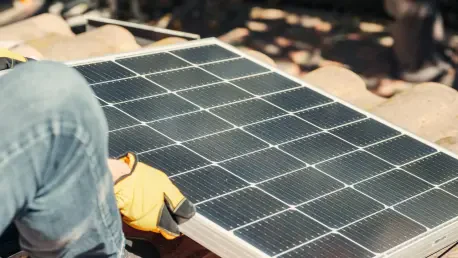In a world increasingly reliant on renewable energy to combat climate change and meet soaring power demands, solar technology stands at a critical juncture with the potential to redefine efficiency standards. A remarkable breakthrough in perovskite silicon tandem solar cells has recently achieved an unprecedented 33.1% efficiency, surpassing the long-standing barriers of traditional silicon-based panels. This milestone, driven by innovative surface treatment techniques, signals a transformative shift in how sunlight can be converted into electricity. The implications of this advancement extend far beyond laboratory success, promising a future where solar power could become even more accessible and effective on a global scale. As researchers tackle the challenges of scalability and integration into existing systems, the question arises: could this be the turning point for solar energy to dominate the renewable sector? This exploration delves into the science behind the achievement, the hurdles overcome, and the path forward for commercial adoption.
Pushing Beyond Silicon’s Limits
The solar industry has long grappled with the inherent constraints of conventional silicon panels, which are approaching a theoretical efficiency ceiling of just under 30%. This cap stems from silicon’s inability to capture the full spectrum of sunlight, leaving significant energy untapped. For years, scientists have sought alternative materials and configurations to break through this barrier and maximize conversion rates. The emergence of perovskite silicon tandem solar cells offers a compelling solution by layering perovskite, a material adept at absorbing diverse light wavelengths, over a silicon base. This combination leverages the strengths of both materials, aiming to exceed the limits of single-junction silicon cells. The recent achievement of 33.1% efficiency underscores the potential of this hybrid approach, marking a pivotal moment in the quest for more powerful solar solutions that can meet growing energy needs with greater effectiveness.
This breakthrough didn’t come without persistent effort to address fundamental challenges in solar cell design. Unlike traditional panels, tandem cells require precise engineering to ensure that the stacked layers work in harmony to optimize light absorption and energy conversion. The perovskite layer, while highly efficient at capturing certain parts of the solar spectrum, must be seamlessly integrated with silicon to avoid energy losses at their interface. Achieving 33.1% efficiency highlights not only the technical prowess behind this innovation but also the potential for tandem cells to redefine industry standards. Experts note that this progress aligns with the broader goal of pushing solar technology beyond incremental gains, focusing instead on transformative leaps. As this technology matures, it could pave the way for solar installations that generate significantly more power from the same surface area, a critical factor in densely populated or space-constrained regions.
Solving the Puzzle of Textured Silicon
A major obstacle in scaling up perovskite silicon tandem cells has been the use of textured silicon, a staple in commercial solar panels due to its pyramid-shaped patterns that enhance light absorption by increasing surface area. However, this uneven surface complicates the application of uniform perovskite layers and effective surface treatments, often leading to defects that sap efficiency. Until recently, high-efficiency results were largely confined to flat silicon surfaces in controlled lab environments, far removed from the realities of industrial production. This limitation posed a significant barrier to bringing tandem cells into mainstream use, as the solar industry relies heavily on textured silicon for its proven performance and cost-effectiveness. Bridging this gap has been a priority for researchers aiming to make tandem technology viable on a larger scale.
The turning point came with the development of a novel chemical treatment using 1,3-diaminopropane dihydroiodide, which enables passivation—a process that reduces energy-wasting defects—on textured silicon surfaces. This innovation has yielded the record-breaking 33.1% efficiency, alongside an impressive open-circuit voltage of 2.01 volts, demonstrating a substantial improvement in performance. Passivation, previously effective only on flat surfaces, now works on the industry-standard textured silicon, making this advancement a game-changer for scalability. The ability to apply this treatment without disrupting existing manufacturing processes suggests that tandem cells could soon transition from experimental prototypes to widespread deployment. This achievement not only addresses a critical technical challenge but also brings the solar sector closer to adopting high-efficiency technologies that can compete with traditional energy sources in terms of output and cost.
Unlocking New Insights into Material Behavior
One of the most intriguing discoveries from this research lies in the unique behavior of passivation in perovskite compared to silicon, offering a deeper understanding of how these materials interact. In silicon, passivation primarily affects the surface, reducing defects where energy loss occurs. However, in perovskite, it extends its influence throughout the entire absorber layer via a phenomenon known as the deep field effect. This unexpected characteristic enhances conductivity and boosts overall cell performance, revealing new dimensions of material science that could shape future solar innovations. Such findings underscore the complexity of tandem cell design and the importance of tailoring treatments to the specific properties of each layer. This insight provides a valuable foundation for optimizing efficiency beyond current benchmarks, potentially leading to even greater advancements in the field.
Building on this discovery, researchers are now equipped with critical knowledge that could accelerate the development of next-generation solar cells. The deep field effect in perovskite suggests that future designs might focus on enhancing internal conductivity rather than just surface-level improvements, opening up novel avenues for experimentation. This contrasts with traditional approaches that prioritized surface treatments alone, often overlooking the broader material dynamics at play. Combined with the record efficiency of 33.1%, these insights position perovskite silicon tandem cells as a frontrunner in renewable energy research. The solar community is abuzz with the potential to refine these findings further, possibly integrating them with other emerging technologies to push efficiency even higher. As understanding of these material interactions deepens, the groundwork is laid for innovations that could transform how solar energy is harnessed and utilized globally.
Bridging the Gap to Commercial Reality
The compatibility of this breakthrough with textured silicon, the cornerstone of current solar manufacturing, represents a significant step toward industrial adoption of tandem cells. Most production lines are already optimized for textured surfaces, meaning that integrating perovskite layers with the new passivation technique requires minimal overhaul of existing infrastructure. This alignment reduces both cost and complexity, key barriers that often delay the rollout of cutting-edge technologies. Experts in the field stress that surface passivation is not merely an optional enhancement but a fundamental necessity for achieving higher efficiency and long-term stability in solar cells. By addressing these core requirements, the recent advancement ensures that tandem technology is not just a lab success but a practical solution poised to impact the broader energy market.
Looking ahead, the focus shifts to refining this technology for mass production while maintaining the high efficiency seen in experimental settings. The solar industry must now tackle challenges like ensuring consistent quality across large-scale batches and managing the durability of perovskite materials under real-world conditions. Collaborative efforts between research institutions and manufacturers will be crucial in streamlining these processes. The achievement of 33.1% efficiency serves as a powerful proof of concept, inspiring confidence that tandem cells can meet stringent commercial demands. With global energy needs continuing to rise, this progress offers a timely opportunity to scale up renewable solutions that deliver more power with fewer resources. The path to widespread adoption appears clearer, setting the stage for solar energy to play an even larger role in the transition to a sustainable future.
Reflecting on a Milestone Achievement
Looking back, the journey to surpassing the 33% efficiency mark with perovskite silicon tandem solar cells stands as a testament to relentless innovation in the face of technical barriers. The application of passivation on textured silicon resolved a long-standing challenge, blending cutting-edge science with practical industry needs. This milestone, marked by a recorded efficiency of 33.1%, redefined what was possible in solar energy conversion at that time. Beyond the numbers, the deeper understanding of material behaviors like the deep field effect in perovskite added layers of knowledge that enriched the field. As the solar sector reflected on this achievement, the focus turned to actionable next steps, such as optimizing production techniques and enhancing material longevity. Future considerations included forging stronger partnerships to test these cells in diverse environments, ensuring they could withstand the rigors of everyday use while maintaining peak performance. This pivotal moment laid a robust foundation for continued exploration and deployment of high-efficiency solar technologies.









